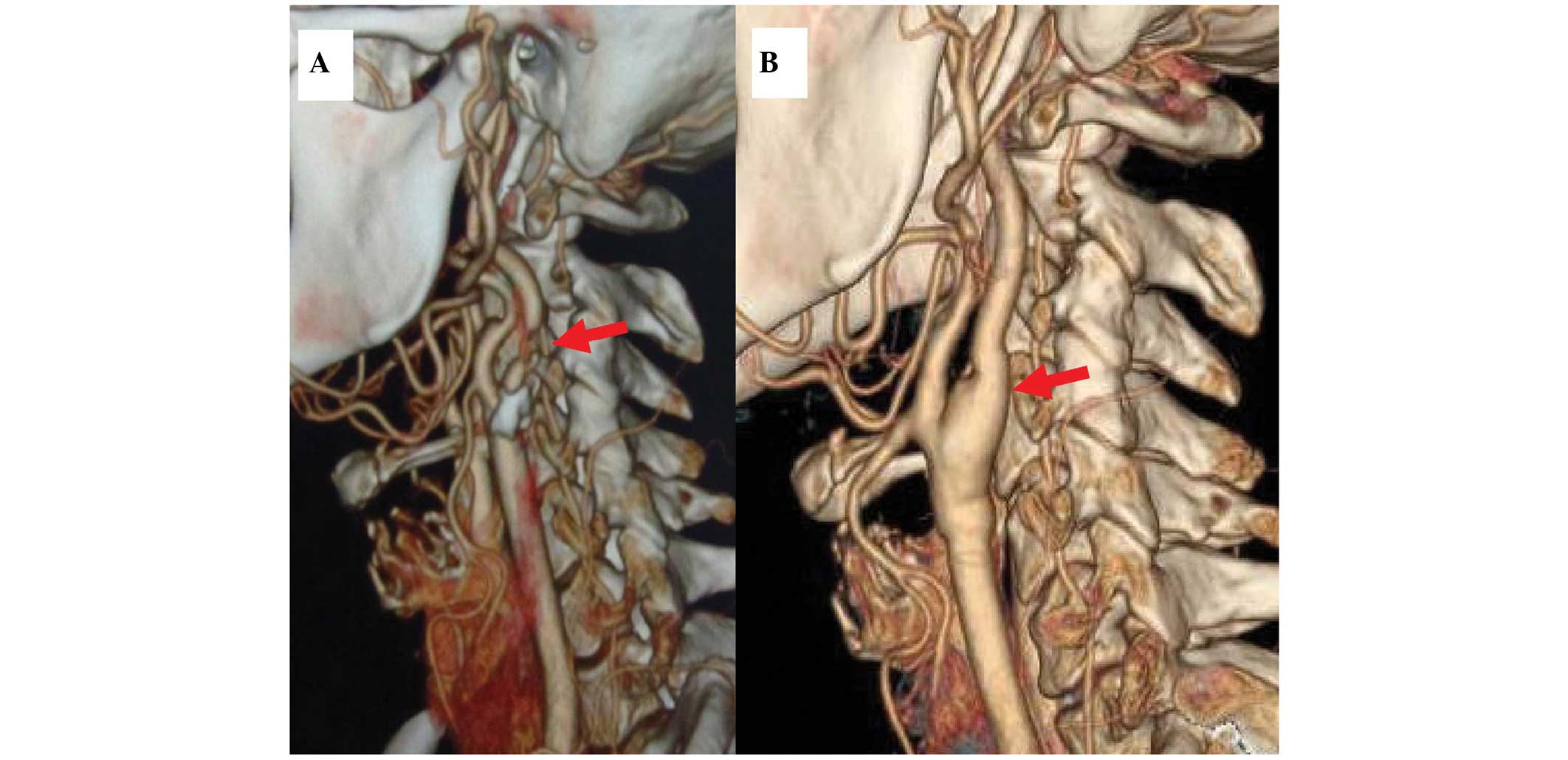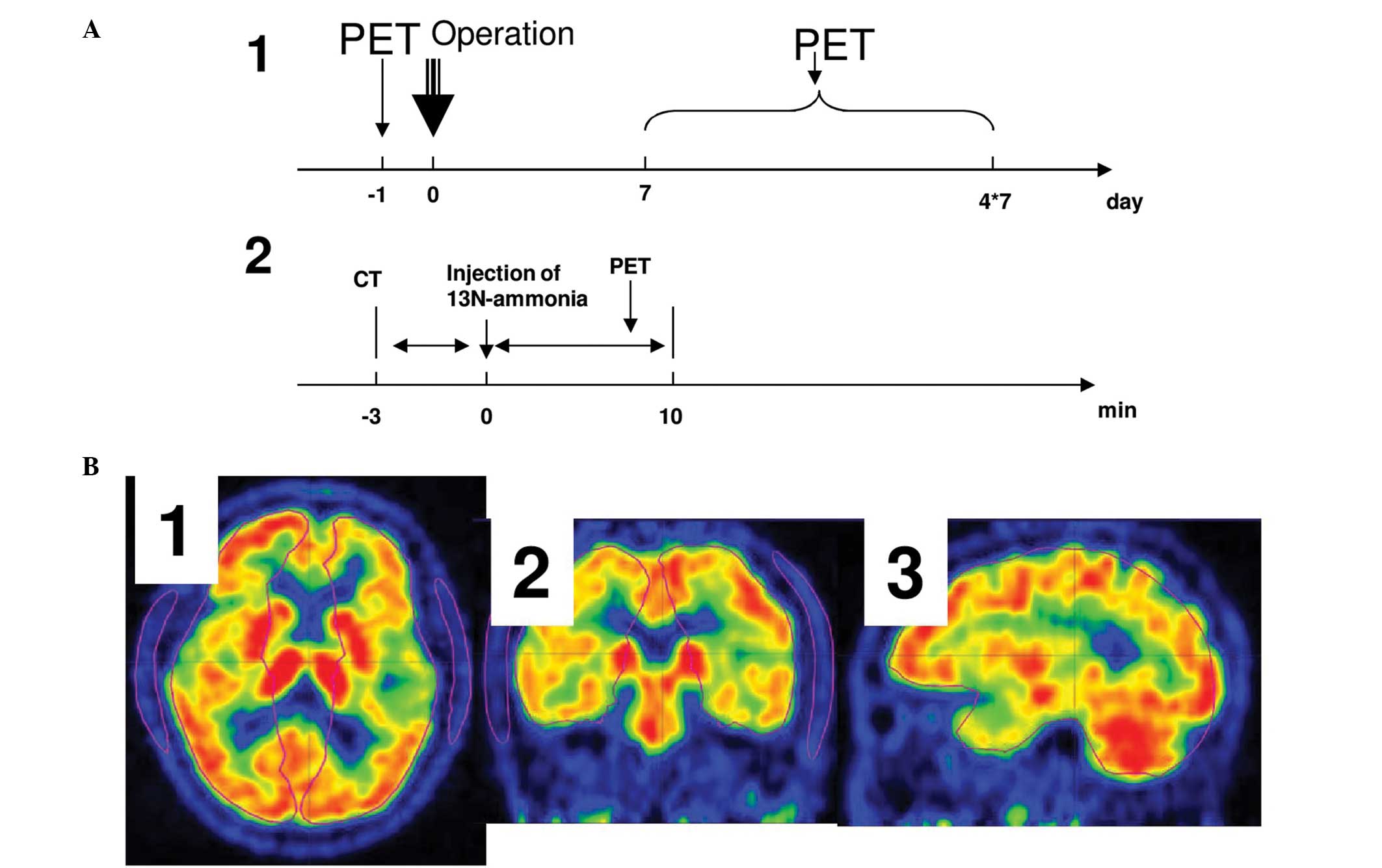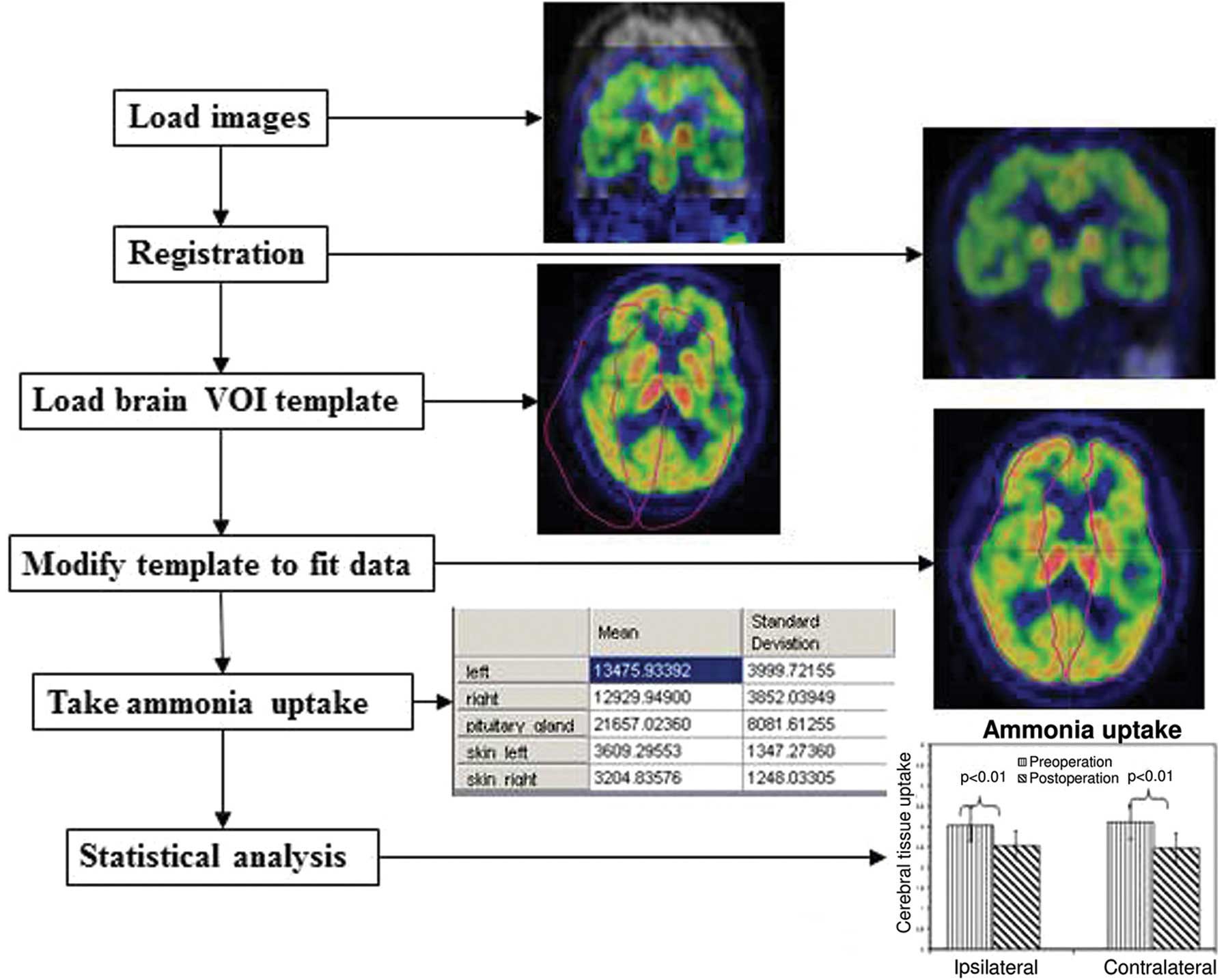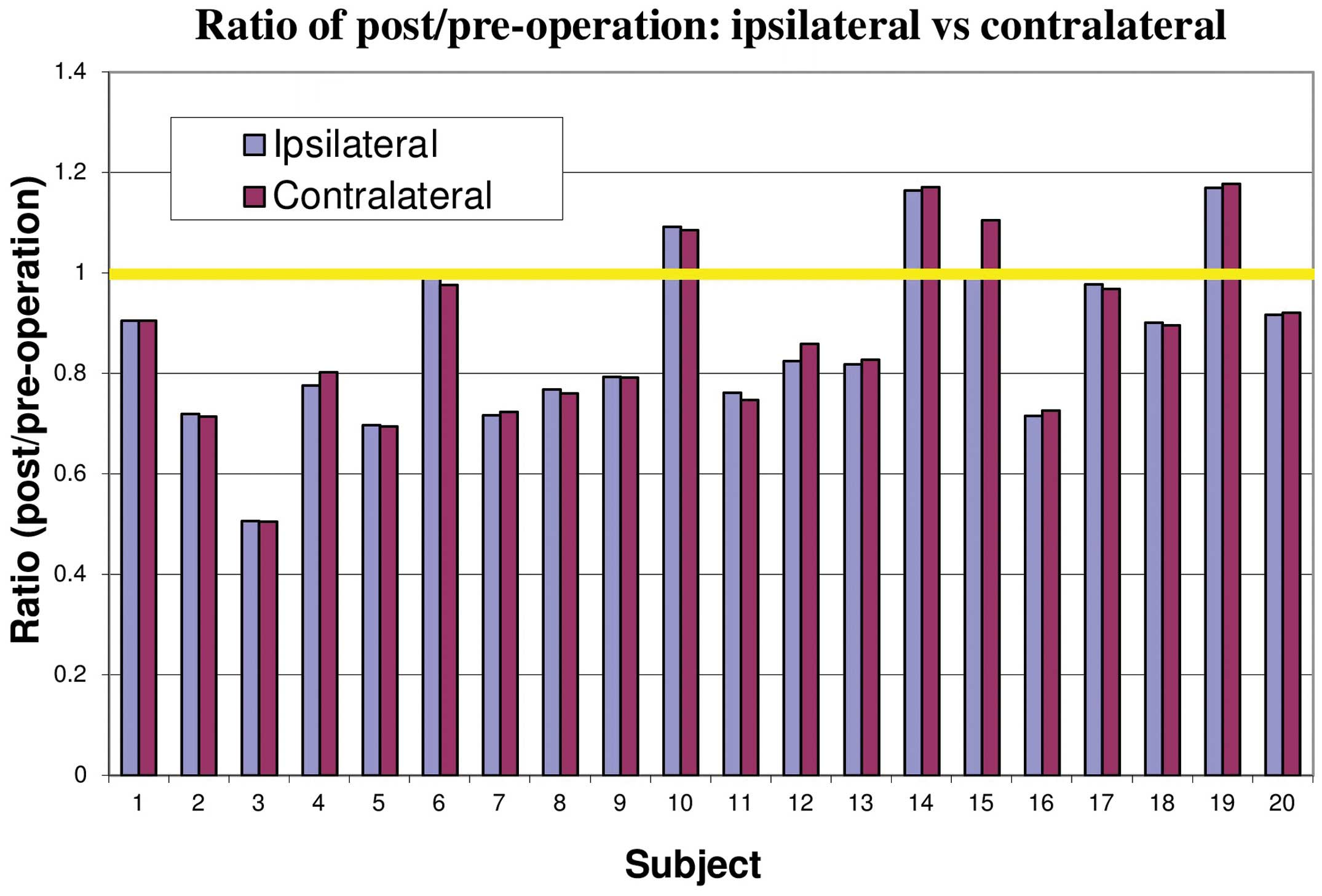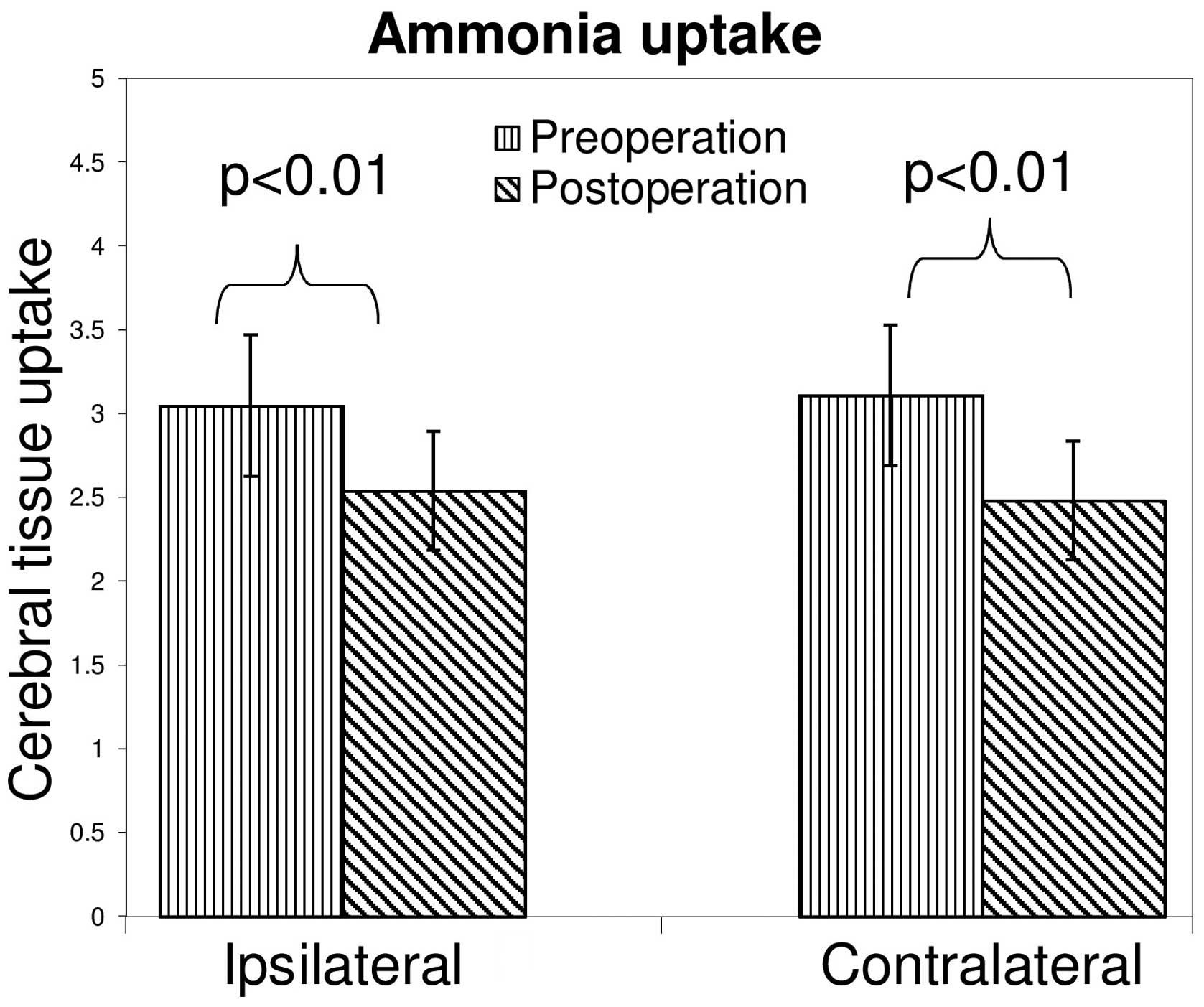Decreased 13N‑labeled ammonia uptake in the ipsilateral and contralateral hemispheres following carotid endarterectomy
- Authors:
- Published online on: September 9, 2015 https://doi.org/10.3892/mmr.2015.4303
- Pages: 6598-6604
-
Copyright: © Wang et al. This is an open access article distributed under the terms of Creative Commons Attribution License.
Abstract
Introduction
Stroke is a major cause of morbidity and mortality in developed and developing countries worldwide. At present, it is recognized that rupture of the carotid atherosclerotic plaque and subsequent formation of thrombi or emboli are the primary causes of ischemic stroke (1–3). Treatment for carotid artery stenosis includes carotid endarterectomy (CEA) and carotid artery stenting (CAS), which are two approaches that have been previously demonstrated to prevent future stroke (4–6).
Improvements in cerebral blood flow following CEA have been observed using various imaging modalities, including transcranial Doppler, single-photon emission computed tomography (SPECT), perfusion computerised tomography (CT) and magnetic resonance imaging (7–11). For the measurement of cerebral tissue perfusion, the use of 15O-labeled water with PET is considered the gold standard, due to the fact that it possesses a high first-pass extraction (12). With 15O-labeled water PET, Rijbroek et al (12) identified that, 1 day following CEA, absolute cerebral blood flow is increased in all arterial territories on the ipsilateral and contralateral hemispheres. In addition, the same study demonstrated no difference in cerebral blood flow between the ipsilateral and contralateral hemispheres prior to and following CEA.
Following carotid artery revascularization, several studies have observed changes in neuropsychological and cognitive functions in humans, including memory, attention, psychomotor speed and executive functions (8,13). In the mammalian cerebral cortex, ≥90% of neurons are glutamatergic or GABAergic, and neuropsychological functions depend on neurotransmitter trafficking between neurons and astrocytes, with ammonia involved in the glutamate/glutamine cycle (14–16).
At present, to the best of our knowledge, there have been no reports focussing on CEA regarding the cerebral uptake of ammonia using 13N-labeled ammonia with PET. The present study aimed to examine the changes in neuropsychological functions following surgery in patients with carotid artery stenosis. It was hypothesized that cerebral ammonia metabolism is altered following CEA, and that this alteration may be associated with GABAergic neuron functions. Therefore, the purpose of the present PET study was to evaluate alterations in ammonia uptake in cerebral hemispheres prior and subsequent to CEA.
Patients and methods
Patients
The present study included 20 patients (four females; 16 males) with a mean age of 59.5 years (range, 33–75 years), who presented with unilateral chronic stenosis between 2011 and 2012 at the Affiliated Hospital of Inner Mongolia Medical University (Hohhot, China). The clinical characteristics of the patients are presented in Table I. No cortical infarctions were observed in the patients on conventional CT prior to CEA. Of the 20 patients, six exhibited carotid artery stenosis of 50–69%, 11 exhibited carotid artery stenosis of 70–99% and three patients exhibited 100% stenosis, termed thrombosis, measured by CT digital subtraction angiography prior to CEA. No patients exhibited occlusion or stenosis ≥50% in the contralateral hemisphere. All study procedures were approved by the Ethics Committee in the Affiliated Hospital of Inner Mongolia Medical University, and written informed consent was obtained from all subjects prior to their enrolment in the study.
Surgical protocol
All patients received antiplatelet therapy (aspirin, 100–200 mg/day) until the morning of the day on which CEA was performed. All patients underwent surgery under general anaesthesia (propofol; initial bolus 1.5–2.5 mg/kg, infusion 100–140 µg/kg/min). Blood pressure was maintained at a stable level, in the range of their preoperative level ±20%, throughout the procedure by adjusting the depth of anaesthesia or, if required, by intravenous administration of a vasodilator (nitroglycerin, ~100 mg/min) or a vasoconstrictor (adrenaline, ~2 mg/min). No intraluminal shunt was used in these procedures. The mean duration of intracranial artery clamping was 30 min, ranging between 20 and 40 min. An angiograph is presented in Fig. 1 as an example prior to and following surgery.
Ulstrasound
High resolution B-mode and Doppler ultrasonography (Vivid 7; GE Healthcare, Milwaukee, WI, USA) of the carotid arteries were performed for each patient prior to surgery to evaluate the severity of vessel stenosis.
PET and CT protocol
13N-ammonia was prepared by the 16O(p,α) 13N nuclear reaction in a water target with a cyclotron (MINItrace; GE Healthcare Life Sciences, Pittsburgh, PA, USA). The target, containing 16O-H2O, was exposed to a 25 µA current for 10–15 min, following which the in-line-produced 13N-NH3 was passed through a Sep-Pak CM column (Plus Accell CM; Waters, Brehamwood, UK), and was separated chromatically by positive ion exchange and use of a filter (EMD Millipore, Billerica, MA, USA), prior to its delivery to patients intravenously.
The PET imaging was performed using a PET/CT scanner (Discovery ST8; GE Healthcare). The CT imaging was performed 3 min prior to the injection of 137 MBq 13N-labeled ammonia. Following injection, PET images were captured immediately for 10 min. The PET images were reconstructed using an ordered subset expectation maximization iterative algorithm, comprising eight subsets; a 128×128 matrix; 3 mm slice thickness and no overlap (12). The PET investigation and scanning protocols used in the present study are illustrated in Fig. 2A.
PET data analysis
Human cerebral hemisphere templates were created covering the majority of the cerebral tissue, including the white matter, grey matter and basal ganglia, as shown in Fig. 2B, in Carimas (a PET data analysis package developed in Turku PET Centre of Finland; http://www.turku-petcentre.fi/carimas). For individual cases, these templates were loaded and modified accordingly to fit the cerebral hemispheres. Additional volume of interest (VOI), covering the lateral skin, was created for each case. The preoperative and postoperative PET image data were loaded into Carimas. Automatic registration using an algorithm developed by Maes et al (17) implemented in Carimas was performed, and all cases exhibited geometric alignment of the PET image with the CT image, as shown in Fig. 2. Ammonia uptake was calculated by taking the average radioactivity in all pixels inside the hemisphere or skin VOIs from the preoperative images and postoperative images. Furthermore, ammonia uptake in the cerebral hemisphere was normalized by the corresponding contralateral skin VOI. The reason for replacing standardized uptake value (SUV) with contralateral skin VOI normalization was due to the fact that the remains of radioactivity in the syringe following the injection were not measured for all cases. Without the measurement of remaining radioactivity, the introduction of bias requires inclusion in the calculation of SUV. All the ammonia uptake numerical data generated in Carimas were saved in ASCII format files for further statistical analysis. An overview of the PET data analysis protocol is presented in Fig. 3.
Statistical analysis
All statistical analyses were performed using Origin 7.0 (OriginLab Corporation, Northampton, MA, USA). Student's t-test was used for the analysis of differences in paired data. P<0.01 was considered to indicate a statistically significant difference.
Results
A total of 20 patients were involved in the present study. The patients' characteristics, including age, gender, side of surgery, postoperative PET scanning time (in days) and stenosis, estimated by ultrasound, are listed in Table I. In total, >50% of the patients (13 patients) suffered from stenosis >80%.
The ratio of ammonia uptake prior to and following CEA for the ipsilateral and contralateral hemispheres is shown in Fig. 4 for each individual patient. The changes in the uptake of ammonia were not significantly different between the ipsilateral and contralateral hemispheres. Ammonia uptake was observed to be higher following CEA in four patients, whereas the uptake in two patients remained almost the same and the remaining patients exhibited significantly reduced uptake.
The mean values of ammonia uptake prior and subsequent to CEA for the ipsilateral and contralateral hemispheres were examined (Fig. 5). Following surgery, the uptake of ammonia was observed to decrease between 3.04±0.42 and 2.54±0.35 (23.2%) in the ipsilateral hemisphere, and between 3.10±0.47 and 2.48±0.36 (23.5%) in the contralateral hemisphere. Changes in ammonia uptake were statistically significant for the right and left hemispheres between the preoperative and postoperative states. However, no significant difference was identified between the two hemispheres preoperatively and postoperatively.
Discussion
In the present study, 13N-labeled ammonia PET was used to examine cerebral ammonia metabolism in patients with severe carotid artery stenosis, by comparing the cerebral ammonia uptake prior to and following CEA. The two key observations were as follows: i) Uptake of ammonia in the ipsilateral and contralateral cerebral hemispheres reduced significantly following treatment; ii) no significant difference in the uptake of ammonia was identified between the ipsilateral and contralateral hemispheres prior to and following CEA.
As an effective treatment approach for symptomatic and asymptomatic carotid artery stenosis, CEA has been in use since the 1950s (18), and CAS has been used more widely and frequently since the 1990s, as an alternative treatment option for this disease (18). A large clinical randomized trial, termed the Carotid Revascularization Endarterectomy vs. Stenting Trial (CREST), sponsored by the National Institutes of Health, demonstrated that carotid stenting and endarterectomy were associated with similar rates of mortality and disabling stroke (19). However, at least among symptomatic patients in the CREST trial, CEA exhibited notably low stroke and mortality rates (20).
Several studies have demonstrated the increase of cerebral blood flow in ipsilateral cerebral territories or hemispheres following CEA or CAS in the short- and long-term, including a study by Yang et al (10) using perfusion CT and a study by Araki et al (21) using transcanial Doppler, SPECT and PET. Of note, using 15O-labeled water, which is known to be the gold standard for measurement of cerebral blood/perfusion, Rijbroek et al (12) observed that blood flow and oxygen consumption are increased in the ipsilateral and contralateral hemispheres following CEA, with no significant difference of these parameters between the ipsilateral and contralateral hemispheres, either preoperatively or postoperatively. The present study demonstrated that the effects of carotid artery stenosis and the improvements of CEA on cerebral blood flow and metabolism were equal to the two hemispheres. This observation can be explained by the effective collateral circulation, or circle of Willis, in the human brain (12). Furthermore, since blood supply is the basis of all metabolism, the observation that ammonia uptake did not change in the present study, was reasonable, based on uniform hemodynamic changes pre- and postoperatively. Combining the findings of the present study with those of Rijbroek et al (12) suggests that unilateral surgery for carotid artery stenosis improves cerebral blood supply and metabolism, not only for the ipsilateral hemisphere, but also for the contralateral hemisphere.
Several studies have investigated the neurological and neuropsychological effects of carotid artery revascularisation, including carotid artery stenting and endarterectomy, in patients with severe carotid artery stenosis or occlusion (22,23). For example, in patients with chronic internal carotid artery occlusion, Lin et al (22) identified that successful carotid artery stenting significantly improves global cognitive function, and attention and psychomotor processing speed. Another study (23) demonstrated that unilateral carotid artery stenting is beneficial to patients with severe asymptomatic stenosis by improving executive function. In humans, neurotransmitters are important in the modulation of neurological and neuropsychological functions, therefore, neurotransmitters are likely to be involved in the neurological and neuropsychological effects following CEA.
13N-ammonia has been validated as a perfusion tracer for use in cardiac PET (24). In brain tissue, the uptake of ammonia is not as closely associated with blood flow as in the myocardium. For example, Phelps et al (24) demonstrated that doubling or halving basal cerebral blood flow resulted in alterations of ammonia uptake of 30–50% in the human brain, and further increases of blood flow were associated with progressively smaller alterations in ammonia uptake. Other studies have demonstrated that the uptake of ammonia is more dependent on the process of glutamine synthesis in the brain (14,16).
In the human cerebral cortex, >90% of neurons are glutamergic or GABAergic, and the high in vivo flux of the glutamate/glutamine cycle in brain cortex puts a significant demand on the return of ammonia, mediated by phosphate-activated glutaminase, between the neurons and astrocytes in order to maintain the nitrogen balance (16). Therefore, changes in the uptake of 13N-labeled ammonia in the human brain are likely to be more sensitive than glutamine metabolism.
The reduced uptake of ammonia in the human brain following carotid CEA observed in the present study suggested two potential hypotheses: Washout by increased blood flow or a negative association between blood flow and uptake of ammonia in human brain tissue.
Washout effect
In human cortex tissue, neurons are surrounded by astrocytes. This anatomical structure in cerebral histology suggests that the exchange of contents between the blood and neurons is modulated by astrocytes. In the glutamate/glutamine and GABA/glutamine cycles, glutamate and ammonia are released in neurons and taken up by astrocytes, where glutamine is synthesized by glutamine synthetase using glutamate and ammonia (14). Previous studies have demonstrated that there is a high flux of ammonia trafficking between neurons and astrocytes. Therefore, the present study hypothesized that increased levels of cerebral blood flow following CEA wash out more ammonia from astrocytes, resulting in a reduction in 13N-labeled ammonia uptake in the patients.
Negative association of cerebral blood flow with ammonia uptake
Hepatic encephalopathy is a worsening of brain function resulting from liver failure, due to the fact that the liver is no longer able to remove ammonia from the blood (25). In patients with hepatic encephalopathy and healthy individuals, blood-borne ammonia readily enters brain tissue and the metabolic trapping in it is correlated with the blood concentration of ammonia (26). However, how ammonia leaves the brain had been debated for a long time. Using 13N-labeled ammonia PET. Sørensen et al revealed that backflux of ammonia from the brain to the blood does indeed occur in healthy individuals and patients with and without hepatic encephalopathy (27). Therefore, combining this finding with the present results, demonstrating a reduction of ammonia uptake in cerebral tissue, it is reasonable to assume that, after CEA, the improved cerebral blood flow accelerates the backflux of ammonia from the brain to the blood, or a negative association between cerebral blood flow and the ammonia uptake in brain tissue.
Certain limitations were identified in the present study. Firstly, no 15O-labeled water was used to measure the cerebral blood flow simultaneously with 13N-labeled ammonia. In addition, dynamic PET scanning was not performed, which has been reported to provide more accurate results for ammonia uptake in brain tissue. These two limitations are due to the lack of a 15O-labeled water device and blood radioactivity measurement devices at the Department of Nuclear Medicine of Inner Mongolia University Hospital of China. Finally, the patients were only scanned 1 month following CEA and no long-term follow up, for example PET scanning 6 months or 1 year-post CEA, was performed. Therefore, whether the reduction of cerebral ammonia uptake is temporary or permanent following CEA remains to be elucidated. These limitations require attention in further investigations.
In conclusion, using 13N-labeled ammonia PET to evaluate cerebral ammonia metabolism following CEA in patients with severe carotid artery stenosis, the present study demonstrated that the uptake of ammonia in the ipsilateral and contralateral hemispheres is significantly reduced. However, no significant differences in ammonia uptake were identified between the two hemispheres, or between ipsilateral and contralateral hemispheres, pre- or postoperatively.
Acknowledgments
The present study was funded by grants to Dr Tao Wang from the Key project from Affiliated Hospital of Inner Mongolia Medical University (grant. no. NYFYBZ2010005), the Natural Science Foundation of Inner Mongolia (grant. no. 20080404MS1125) and the Medical Research Plan of Inner Mongolia Public Health in 2010 (grant. no. 2010024); to Dr Xia Bai by the Scientific and Technological Project of Inner Mongolia Education and to Dr Chunlei Han by the Centre of Excellence in Cardiovascular and Metabolic Imaging of Academy of Finland. The authors would like to thank Mr. Vesa Oikone of Turku PET Centre of Finland for his assistance with the preparation of this manuscript. The abstract of the present study was previously published in the Annual Congress of the Association of Nuclear Medicine, Lyon, France, pS339, 2013.
References
|
Silver FL, Mackey A, Clark WM, Brooks W, Timaran CH, Chiu D, Goldstein LB, Meschia JF, Ferguson RD, Moore WS, et al CREST Investigators: Safety of stenting and endarterectomy by symptomatic status in the carotid revascularization endarterectomy versus stenting trial (CREST). Stroke. 42:675–680. 2011. View Article : Google Scholar : PubMed/NCBI | |
|
Pennekamp CW, Immink RV, den Ruijter HM, Kappelle LJ, Ferrier CM, Bots ML, Buhre WF, Moll FL and de Borst GJ: Near-infrared spectroscopy can predict the onset of cerebral hyperperfusion syndrome after carotid endarterectomy. Cerebrovasc Dis. 34:314–321. 2012. View Article : Google Scholar : PubMed/NCBI | |
|
Russjan A, Goebell E, Havemeister S, Thomalla G, Cheng B, Beck C, Krützelmann A, Fiehler J, Gerloff C and Rosenkranz M: Predictors of periprocedural brain lesions associated with carotid stenting. Cerebrovasc Dis. 33:30–36. 2012. View Article : Google Scholar | |
|
Buczek J, Karliński M, Kobayashi A, Białek P and Członkowska: Hyperperfusion syndrome after carotid endarterectomy and carotid stenting. Cerebrovasc Dis. 35:531–537. 2013. View Article : Google Scholar : PubMed/NCBI | |
|
Mantese VA, Timaran CH, Chiu D, Begg RJ and Brott TG; CREST investigators: The Carotid Revascularization Endarterectomy versus Stenting Trial (CREST): Stenting versus carotid endarterectomy for carotid disease. Stroke. 41(Suppl): S31–S34. 2010. View Article : Google Scholar : PubMed/NCBI | |
|
Bond R, Rerkasem K, Cuffe R and Rothwell PM: A systematic review of the associations between age and sex and the operative risks of carotid endarterectomy. Cerebrovasc Dis. 20:69–77. 2005. View Article : Google Scholar : PubMed/NCBI | |
|
Saito H, Kuroda S, Hirata K, Magota K, Shiga T, Tamaki N, Yoshida D, Terae S, Nakayama N and Houkin K: Validity of dual MRI and F-FDG PET imaging in predicting vulnerable and inflamed carotid plaque. Cerebrovasc Dis. 35:370–377. 2013. View Article : Google Scholar : PubMed/NCBI | |
|
Nanba T, Ogasawara K, Nishimoto H, Fujiwara S, Kuroda H, Sasaki M, Kudo K, Suzuki T, Kobayashi M, Yoshida K and Ogawa A: Postoperative cerebral white matter damage associated with cerebral hyperperfusion and cognitive impairment after carotid endarterectomy: A diffusion tensor magnetic resonance imaging study. Cerebrovasc Dis. 34:358–367. 2012. View Article : Google Scholar : PubMed/NCBI | |
|
Vanninen E, Kuikka JT, Aikiä M, Könönen M and Vanninen R: Heterogeneity of cerebral blood flow in symptomatic patients undergoing carotid endarterectomy. Nucl Med Commun. 24:893–900. 2003. View Article : Google Scholar : PubMed/NCBI | |
|
Yang B, Chen W, Yang Y, Lin Y, Duan Y, Li J, Wang H, Fu F, Zhuge Q and Chen X: Short- and long-term hemodynamic and clinical effects of carotid artery stenting. AJNR Am J Neuroradiol. 33:1170–1176. 2012. View Article : Google Scholar : PubMed/NCBI | |
|
Trojanowska A, Drop A, Jargiello T, Wojczal J and Szczerbo-Trojanowska M: Changes in cerebral hemodynamics after carotid stenting: Evaluation with CT perfusion studies. J Neuroradiol. 33:169–174. 2006. View Article : Google Scholar : PubMed/NCBI | |
|
Rijbroek A, Boellaard R, Vermeulen EG, Lammertsma AA and Rauwerda JA: Hemodynamic changes in ipsi- and contralateral cerebral arterial territories after carotid endarterectomy using positron emission tomography. Surg Neurol. 71:668–676. 2009. View Article : Google Scholar | |
|
Gaudet JG, Meyers PM, McKinsey JF, Lavine SD, Gray W, Mitchell E, Connolly ES Jr and Heyer EJ: Incidence of moderate to severe cognitive dysfunction in patients treated with carotid artery stenting. Neurosurgery. 65:325–329. 2009. View Article : Google Scholar : PubMed/NCBI | |
|
Rothman DL, De Feyter HM, Maciejewski PK and Behar KL: Is there in vivo evidence for amino acid shuttles carrying ammonia from neurons to astrocytes? Neurochem Res. 37:2597–2612. 2012. View Article : Google Scholar : PubMed/NCBI | |
|
Adeva MM, Souto G, Blanco N and Donapetry C: Ammonium metabolism in humans. Metabolism. 61:1459–1511. 2012. View Article : Google Scholar | |
|
Cooper AJ: 13N as a tracer for studying glutamate metabolism. Neurochem Int. 59:456–464. 2011. View Article : Google Scholar : | |
|
Maes F, Collignon A, Vandermeulen D, Marchal G and Suetens P: Multimodality image registration by maximization of mutual information. IEEE Trans Med Imaging. 16:187–198. 1997. View Article : Google Scholar : PubMed/NCBI | |
|
Gröschel K, Schnaudigel S, Pilgram SM, Wasser K and Kastrup A: A systematic review on outcome after stenting for intracranial atherosclerosis. Stroke. 40:e340–e347. 2009. View Article : Google Scholar : PubMed/NCBI | |
|
Gahremanpour A, Perin EC and Silva G: Carotid artery stenting versus endarterectomy: A systematic review. Tex Heart Inst J. 39:474–487. 2012.PubMed/NCBI | |
|
Timaran CH, Mantese VA, Malas M, Brown OW, Lal BK, Moore WS, Voeks JH and Brott TG; CREST Investigators: Differential outcomes of carotid stenting and endarterectomy performed exclusively by vascular surgeons in the Carotid Revascularization Endarterectomy versus Stenting Trial (CREST). J Vasc Surg. 57:303–308. 2013. View Article : Google Scholar : | |
|
Araki CT, Babikian VL, Cantelmo NL and Johnson WC: Cerebrovascular hemodynamic changes associated with carotid endarterectomy. J Vasc Surg. 13:854–859. 1991. View Article : Google Scholar : PubMed/NCBI | |
|
Lin MS, Chiu MJ, Wu YW, Huang CC, Chao CC, Chen YH, Lin HJ, Li HY, Chen YF, Lin LC, et al: Neurocognitive improvement after carotid artery stenting in patients with chronic internal carotid artery occlusion and cerebral ischemia. Stroke. 42:2850–2854. 2011. View Article : Google Scholar : PubMed/NCBI | |
|
Mendiz OA, Sposato LA, Fabbro N, Lev GA, Calle A, Valdivieso LR, Fava CM, Klein FR, Torralva T, Gleichgerrcht E, et al: Improvement in executive function after unilateral carotid artery stenting for severe asymptomatic stenosis. J Neurosurg. 116:179–184. 2012. View Article : Google Scholar | |
|
Phelps ME, Huang SC, Hoffman EJ, Selin C and Kuhl DE: Cerebral extraction of N-13 ammonia: Its dependence on cerebral blood flow and capillary permeability - surface area product. Stroke. 12:607–619. 1981. View Article : Google Scholar : PubMed/NCBI | |
|
Butterworth RF: Pathophysiology of hepatic encephalopathy: A new look at ammonia. Metab Brain Dis. 17:221–227. 2002. View Article : Google Scholar | |
|
Keiding S, Sørensen M, Bender D, Munk OL, Ott P and Vilstrup H: Brain metabolism of 13N-ammonia during acute hepatic encephalopathy in cirrhosis measured by positron emission tomography. Hepatology. 43:42–50. 2006. View Article : Google Scholar | |
|
Sørensen M, Munk OL and Keiding S: Backflux of ammonia from brain to blood in human subjects with and without hepatic encephalopathy. Metab Brain Dis. 24:237–242. 2009. View Article : Google Scholar |



